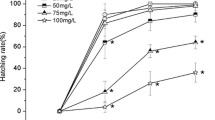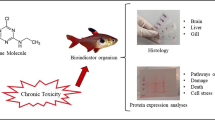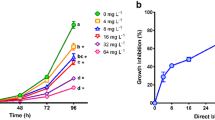Abstract.
Ultrastructural alterations in liver and gills of embryonic and larval zebrafish (Danio rerio) following prolonged exposure to waterborne 0.05, 0.5, and 5 mg/L 4-chloroaniline for up to 31 days as well as after a 14-day regeneration period were investigated by means of light and electron microscopy. Acute toxicity was also tested at 25 and 50 mg/L. Survival of zebrafish embryos and larvae was only impaired from 25 mg/L 4-chloroaniline, but—after a transient stimulation following exposure to 0.5 mg/L—4-chloroaniline hatching was retarded after exposure to ≥5 mg/L, and fish displayed increasing rates of abnormal development and pigmentation. In contrast, hepatocytes displayed a time- and dose-dependent response from 0.05 mg/L 4-chloroaniline, including changes in nuclei, mitochondria, peroxisomes, endoplasmic reticulum, Golgi fields, lysosomes, and hepatic glycogen and lipid stores, as well as invasion of macrophages. In gills, dose-dependent effects were evident from 0.5 mg/L 4-chloroaniline and included deformation of secondary lamellae due to vacuolization and desquamation of respiratory epithelial cells in conjunction with dilation of intercellular spaces. Respiratory epithelial cells displayed progressive mitochondrial changes, induction of cytoplasmic myelinated structures, augmentation of lysosomes, and modifications of Golgi fields. Erythrocytes were severely deformed. A 14-day regeneration period was sufficient for almost complete recovery of pathological symptoms in both liver and gills. Only minor volumetric changes in hepatocellular organelles and a limited number of myelinated bodies, lysosomes, and cytoplasmic vacuoles were reminiscent of prior 4-chloroaniline exposure. In both qualitative and quantitative terms, most effects in hepatocytes after exposure of embryonic and larval zebrafish to waterborne 4-chloroaniline are comparable to the reaction of hepatocytes in adult zebrafish liver after prolonged sublethal exposure as well as in larval zebrafish after microinjection. Morphological changes in erythrocytes indicate disturbance of respiration as an additional mode of action of 4-chloroaniline.
Similar content being viewed by others
Author information
Authors and Affiliations
Additional information
Received: 8 July 1998/Accepted: 18 November 1998
Rights and permissions
About this article
Cite this article
Burkhardt-Holm, P., Oulmi, Y., Schroeder, A. et al. Toxicity of 4-Chloroaniline in Early Life Stages of Zebrafish (Danio rerio): II. Cytopathology and Regeneration of Liver and Gills After Prolonged Exposure to Waterborne 4-Chloroaniline. Arch. Environ. Contam. Toxicol. 37, 85–102 (1999). https://doi.org/10.1007/s002449900493
Issue Date:
DOI: https://doi.org/10.1007/s002449900493




